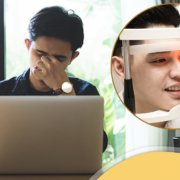From personal workouts, and boxing classes, to barre classes, interactive spin classes, indoor climbing, cross-fit gyms, and run clubs, one thing remains pretty clear. None of them are easy (or recommended) while you are wearing glasses.
As you can tell in all fitness magazines, corrective lenses are not gracing the cover of any of their models. It’s just not practical to do a box jump while you’re wearing glasses.
This is one good reason why you should really think about LASIK, especially if you’re a gym buff.
Here are the reasons why glasses won’t work when you work out:
1. HIIT (High-Intensity Interval Training)
High-Intensity Interval Training (or CrossFit as many of us refer to it) has become one of the most popular workouts we see these days, and as everyone knows thanks to social media, it’s intense. It becomes very close to impossible if you’re going to have to adjust your glasses every 30 seconds as you switch from burpees to jump squats to push-ups and repeat. Those short moments of intense exertion will burn off all those cheat meals and really ignite your metabolism quickly. We can only hope your glasses don’t fly off while you burn off that dessert.
2. Group Training
Many of us need motivation and support to fully get into working out. We end up walking aimlessly around the gym and not really completing anything if we don’t have guidance. Trying to keep up with your instructor and seeing if you can keep up with the new spinning “lingo” or those unfamiliar hip hop or Zumba moves is not easy, but it’s challenging. Want a real challenge though? Try to make sure your glasses stay secure on your face. All it takes is someone next to you to step the wrong way and bam, there go your glasses.
3. Destination Fitness
Does working out while on vacation freak you out? Well, many would disagree as resorts are now being built around fitness! Yoga retreats can be found in exotic areas around the world. Marathon runners also report that running 5,000 miles away helps them train better! No matter what your reason is, with any vacation or travel plan: your glasses case is bulky, but you need it because what if you want to take them off and they get scratched or crushed in your carry-on? Then once you are there, you dream about leaving them back in your hotel room but then you think about a potential headache during your fitness class, which turns out not to be too relaxing of a “retreat”!
4. Boxing/Defense Classes
Some of the awesome new fitness gyms are based around boxing and kickboxing these days. You probably see them sprouting up in every strip mall near you! This workout is high-intensity and high-calorie burning. You’ll need great hand-eye coordination to perfect your punch and you will need to learn how to duck, swing and pivot at the right times. As hard as it is a workout and to become a boxing expert, one easy little punch from a classmate and you’re frames are down along with a trip to your eye doctor. Now that hurts.
5. Indoor Climbing
Talk about elevating your fitness regime. Indoor rock climbing is a full-body workout that gets your body and your heart rate up. You’ll be constantly on the lookout for the next small rock you can grab to climb higher. Don’t forget that your hands will also be covered in chalk, and if you brush past your lenses, you may need to reset them as the white powder will absolutely fuzz up your frames.
6. Stand-Up Paddle Board Yoga
Balancing while on a narrow platform while at the mercy of waves of all sizes sounds like a killer ab and core workout. If you’ve embraced this challenging workout, out, chances are, you already know the truth: you may get wet. And if you fall, which most of us do on our first few tries – your glasses will likely find a new home at the bottom of the river, lake, or ocean you are paddling on…
7. VR Workouts
Have you heard about these? We no longer have to sit on a spin bike as we can actually pretend we are biking through the countryside in Spain! Or jogging on a European mountain trail! Sounds like a fun workout that you would completely immerse yourself in except, you have to wear one of those VR headsets. This means you’ll have to leave your glasses in the past because VR headsets don’t fit so easily over your glasses.
Chances are, if you try any of the cutting-edge workouts we’ve shared, you have a big goal, and/or you are adventurous. So not only could your glasses be holding you back from reaching your fitness potential, but your future probably holds a ton of adventurous experiences where having frames on your face will just keep getting in your way.
If you haven’t thought about it in a while, maybe you should take another look at LASIK. Did you know our doctors have done the most surgeries in the country, and therefore have the longest experience with it?
If you’ve “thought” about it or maybe looked into it years ago and need a refresher on what has changed and what we have learned, come in for a consultation and a screening.
What is there to lose? Just think, by the time your trip comes, you could be free from glasses falling off at the gym or having to pack contact lens solutions or cases. Seeing better without glasses can not only be freeing and convenient, it can also be less expensive in the long run. It’s a win-win!
Call our Patient Care Lines: (+632) 7-368 5238 l (+63) 917 862 7454 l (+63) 921 217 0517 for inquiries, questions, and appointments or talk to our consultants via LiveChat here on our website.






